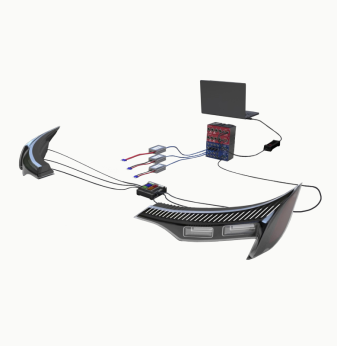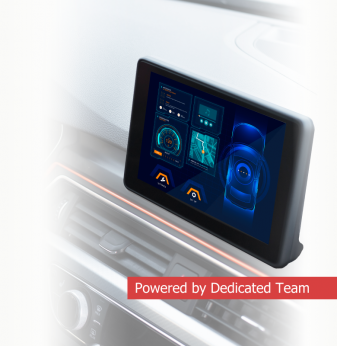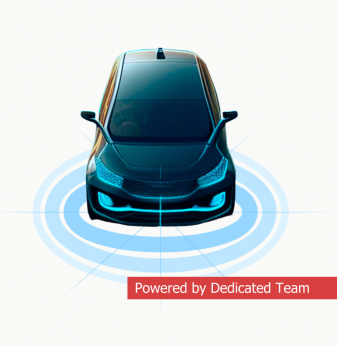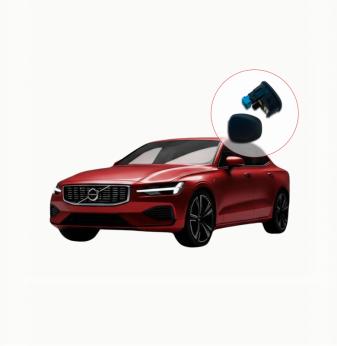Poor Roads, Money, and Cybercriminals: Why Sci-fi Cars are Not Here Yet

The flying taxis with smart assistants from the Fifth Element, a stunning Audi RSQ, custom built by Audi for I, Robot, and the Lexus 2054 with advanced biometric systems and automatic driving mode from Minority Report: it seems automakers from around the world are racing to be the first to make these dreams come true.
While such advanced hi-tech vehicles have yet to become our new reality, the industry is not standing still, with fully driverless cars already driving passengers on the streets of San Francisco and Phoenix. But how far has the automotive industry actually moved forward? What sci-fi vehicle components have manufacturers and embedded software companies already made true, and what is yet to be achieved? Let’s observe.
Table of contents
Are self-driving robotaxis real?
Self-driving cars: why not now?
Innovations need practical value to make future vehicles a reality
Are self-driving robotaxis real?
In 2017, Waymo, formerly known as the Google self-driving car project, put its autonomous minivans on public roads in Arizona with no safety driver behind the wheel or any human at all. Fascinating, isn’t it? The further, the better! Three years later, the company launched its fully driverless taxi service, Waymo One, on the streets of Phoenix and San Francisco. It may seem like the future is finally here.
However, today, seven years later, robotaxis and self-driving cars are still not a part of our everyday life. The automated public transport by Waymo is a great, bold experiment. But the challenges connected with putting driverless vehicles on the roads turned out to be a rabbit hole, revealing plenty of ethical, legal, and technical constraints to consider the further you go down.
The safety-first approach is of the highest priority in the automotive industry, which is why the Society of Automotive Engineers (SAE) offered to classify all vehicles with 6 levels of automation, with Level 0 taken as “no automation” and Level 5 as “full automation”. Honda is the first manufacturer to have introduced a certified level-3 automation model, the Honda Legend, closely followed by Mercedes-Benz with a certified SAE Level 3 Drive Pilot.
Level 3, or “conditional automation”, is a great milestone for the industry. However, it’s too early to speak about the mass adoption of level-3 automated vehicles, until hands-free driving is introduced in the road safety legislation across the world. While industry insiders claim personal vehicles won’t achieve full automation by 2035, the phenomenon of Waymo needs explanation.
Self-driving cars: why not now?
To make the vehicle move according to road traffic regulations, it must be fully aware of the conditions it is moving in, including the road marking, road signs, obstacles, and other participants of road traffic in any weather conditions.
Mercedes EQS models, going together with the abovementioned level-3 Drive Pilot, have a complex system of cameras, powered by computer and stereoscopic vision, and sensors to instantly analyze traffic density and road surface quality. The combination of road moisture sensor, light detection and ranging, or lidar, ultrasonic sensor in the Mercedes car offers automated driving up to 60 kph on suitable freeway sections with high traffic density.
The conditions must indeed be “suitable”, for the unpredictable and at times chaotic urban traffic requires the driver’s full participation. Pedestrians running across the roads, billboards hindering image recognition, unclear road markings, bumps, car accidents – the systems, capable of containing and processing such huge volumes of data, are still non-existent. There’s a possibility to improve locality detail with more sensors, which will inevitably lead to a significant jump in price.
At the current stage of technology development, the cost of a basic Mercedes EQL is expected to start at $105,550. It’s a considerable price, in comparison to Tesla’s top Model S Plaid, going now for $81,490, or a new beautiful Porsche 718 Cayman GTS 4.0 for $96,850. Researchers and engineers require time and substantial financing to introduce more powerful and better-performing technologies to make such vehicles affordable.
Getting back to the self-driving Waymo One and the aspects which made driver-less robotaxis a reality in 2020. Arizona was a smart choice to start, as the laws regulating autonomous tests are practically non-existent in the state, according to reports. This fact let the company put the vehicles to the test. Today, the locality covered by Waymo is still very limited (Phoenix, San Francisco and Los Angeles). Before introducing Waymo One in a new city, the company makes a full scanning of the city streets, making a highly detailed map to make sure the car does not park in some private backyard.
The technology is not perfect, though, which is unacceptable when it comes to human health and safety. Traffic violations of self-driving cars may differ from the vehicle parking in a fire lane to more serious car accidents, like the one when two Waymos hit one and the same truck.
Software-defined vehicles
Speaking of sci-fi cars, it’s impossible not to mention software-defined vehicles, or SDVs. Batmobile is a great sci-fi example of what a vehicle can achieve with advanced software systems implemented. While Batmobile stays on the other side of reality, the vehicles whose functions are primarily enabled through software, are more than real.
Much like smartphones, these vehicles can receive continuous upgrades and new features through over-the-air updates, with no physical action required. Moreover, modern SDVs are equipped with ADAS – advanced driver assistance systems – which process the data received from cameras and sensors, providing enhanced safety with lane departure warnings, collision avoidance, and adaptive cruise control.
The integration of vehicle-to-everything (V2X) communications standards makes the potential of SDVs truly incredible, embedding personal transport into the ecosystem of smart city infrastructure, social services, other vehicles, and connected devices. Embedded software companies are actively contributing to developing such ecosystems by connecting all elements of traffic with software ties. Great examples include AI-based car plate recognition systems, traffic management systems like the ones successfully working in Lille, driver behavior analysis, adaptive traffic signals, and smart corridors.
Cybersecurity
While the evolution of technology will certainly take time and effort from manufacturers and OEMs, cybersecurity is expected to be one of the major challenges for the industry in the coming years.
As the sole suppliers of software in their vehicles, manufacturers implement various protection measures against external system access attempts. Due to the unique architecture of software-defined vehicles, comprising hardware, software, and data, each level requires a distinct approach to protection. The high connectivity of SDVs exposes the vehicles to increased risks of system penetration, compelling automakers to adopt a zero-trust safety approach.
SDVs are not closed-looped systems. Over-the-air programming, connected devices such as smartphones, as well as access to GPS, Wi-Fi, and Bluetooth, all risk becoming entry points into the system. One of the secure software development practices, adopted by manufacturers, is the use of the Rust programming language.
The Autosar partnership, an automotive standards group, whose members include such industry leaders as Mercedes, Stellantis, Volvo, BMW, and Toyota, announced the Rust Working Group to explore the opportunities of the language. Rust is noted for its robust security measures, including encryption, intrusion detection systems, and secure over-the-air update protocols. Additional measures associated with software protection include the development of intrusion detection systems, pre-installing firewalls, and implementing crypto algorithms and protocols.
Sensors and cameras, responsible for collecting data about the surrounding environment are another vulnerability of software-defined vehicles. By deceiving the sensors with false signals, cybercriminals could cause significant harm to the driver, the passengers, and the people nearby.
To standardize safety efforts, the industry is rallying around the ISO/SAE 21434 and UNECE WP.29 standards. These guidelines provide a comprehensive framework for cybersecurity in automotive design, development, and maintenance throughout a vehicle’s lifecycle. On 07 July 2024, the EU General Safety Regulation II came into force in Europe, defining safety regulations that all new vehicles in the EU will now comply with.
Some critical safety features will no longer be optional, but mandatory for all new vehicles in the EU, like advanced emergency braking systems, emergency lane keeping, emergency stop signals, driver drowsiness and attention warning, and so on.
Innovations need practical value to make future vehicles a reality
When dreaming about the vehicles of the future, film directors and artists primarily focus on visual attractiveness, which usually has not so much in common with reality. Real life, however, demands innovations to bring practical value first.
Rather than pursuing flashy dreams, engineers and manufacturers are joining forces to successfully achieve mass adoption of level-3 automated vehicles, taking their first steps towards automation level 4, rather than equipping cars with wings. This approach may not mirror the exciting visions portrayed in movies, but it ensures a future that is better, more convenient, and ultimately safer when it becomes a reality.
Do you need engineering support for your automotive project?



































